Madagascar - A wildlife trek
"In search of the Silky Sifaka" Madagascar, November 2000
Madagascar is an unusual country with unique wildlife and visiting the country had long been an ambition for us. One of our first actions on retiring was to arrange this trip. We did it in November, which is the recommended month for wildlife viewing and had never been possible when we were working.
The flavour of this trip, as-organised, was definitely set as "wildlife", even to odd references to people on the trip as "naturalists".
15 Nov
From Heathrow to Paris, where we got an Air Madagascar flight direct to Antanarivo.
16 Nov
Our arrival at Antananarivo Ivato International Airport was in the early morning. Onward flights to Nosy Be and then Diego Suarez were domestic flights in "normal" airliners.
From the airport our transport took us through the poverty of the town and along the coast around the famous Diego Suarez Bay. It had been an Portuguese port in the days when Africa was first explored. The bay is a huge affair, almost totally enclosed from the sea and with a little pointed rocky island rising from the middle. The road around the bay was quiet and dilapidated; even so it had police patrols that carefully inspected our driver's documents. Very little was built along the road, apart from our hotel, the Kings Lodge. This modest but comfortable building in bare surroundings faced the bay across the road and beach. All the rooms opened out onto a veranda where one can relax sitting and looking out across the sunny bay. After our long journey it was good to wander around the beach and to sit in the warm sunshine on the veranda.
Later dinner was in the central open-fronted dining room. It was a chance to meet the rest of our party. There were 8 in the party with 2 more to join us later plus our leader, Nick Garbutt, and our ever-smiling camp chief "Hairy". It was not until the very last day of the tour that this clean-shaven gentleman gave us a business card with his name "Herilala" written on it.
17 Nov
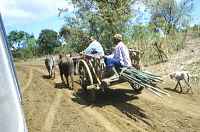 After a slightly rushed breakfast (I set our clock an hour out!) we set off by road in a fleet of comfortable 4wd vehicles. We were on our way to the Ankarana Special Reserve. The initial part of the journey was along superb tarmac roads carrying little traffic. After these we turned off to dirt roads and began to see why the 4wd vehicles were needed for most of the year. For us in November, there was only dust and a bumpy surface to contend with, but there was much evidence of fierce struggles back in the rainy season. e.g. There were tree branches embedded in the mud and multiple wheel grooves over a huge area each side of the official road. We saw few vehicles on the road and these included a good sprinkling of ox-carts.
After a slightly rushed breakfast (I set our clock an hour out!) we set off by road in a fleet of comfortable 4wd vehicles. We were on our way to the Ankarana Special Reserve. The initial part of the journey was along superb tarmac roads carrying little traffic. After these we turned off to dirt roads and began to see why the 4wd vehicles were needed for most of the year. For us in November, there was only dust and a bumpy surface to contend with, but there was much evidence of fierce struggles back in the rainy season. e.g. There were tree branches embedded in the mud and multiple wheel grooves over a huge area each side of the official road. We saw few vehicles on the road and these included a good sprinkling of ox-carts.
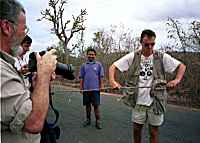 Our drivers proved very good at spotting Chameleons on the roadside bushes. The worth of Nick's experience with animals immediately showed itself as he coaxed the chameleons on to suitable branches and anticipated their movements for us as we took photos. Chameleons are very unusual animals and we enjoyed seeing them close-up. I had never registered the pincer-like nature of their hands until I had one walking slowly over my fingers.
Our drivers proved very good at spotting Chameleons on the roadside bushes. The worth of Nick's experience with animals immediately showed itself as he coaxed the chameleons on to suitable branches and anticipated their movements for us as we took photos. Chameleons are very unusual animals and we enjoyed seeing them close-up. I had never registered the pincer-like nature of their hands until I had one walking slowly over my fingers.
We not previously been used to such luxury living as having comfortable and efficient transport and we wondered what standard our camping would be. In the event it proved to be in small 2-man tents, already set up for us among the trees of a campsite with very basic toilet and shower facilities. This seemed fine and we felt excited to be camped just below the tsingy cliffs.
Tsingy is a weird and very distinctive mass of eroded limestone pinnacles consisting of vast flakes with wickedly sharp edges. It had fascinated us ever since we first read about it in Jane Wilson's book "Lemurs of the lost World", which had been instrumental in making a visit here so important to us. (In our years of waiting for the Madagascar visit we had met
something similar in Borneo
, but not on this scale.)
 In the afternoon we went for our first wildlife walk. There were a limited number of footpaths picking their way through the trees, which largely obscured the tsingy above us. Conditions on the paths could well have been a wilder part of Europe on a hot day. There were plenty of birds to be seen. We did find a python, which was handed round a few of the party. I found it had a strangely damp feel to the touch, but someone later told me it had been in a rock pool when Nick first caught it! Soon we had also had a good view of a Lepilemur. These are normally nocturnal, but ours and its infant were peering down at us from their daytime shelter in a hollow of a tree of some 10m above us.
In the afternoon we went for our first wildlife walk. There were a limited number of footpaths picking their way through the trees, which largely obscured the tsingy above us. Conditions on the paths could well have been a wilder part of Europe on a hot day. There were plenty of birds to be seen. We did find a python, which was handed round a few of the party. I found it had a strangely damp feel to the touch, but someone later told me it had been in a rock pool when Nick first caught it! Soon we had also had a good view of a Lepilemur. These are normally nocturnal, but ours and its infant were peering down at us from their daytime shelter in a hollow of a tree of some 10m above us.
Soon we saw our first lemurs scrambling through the trees above us. Whilst this was exciting it had all the frustrations of watching monkeys and realising how minimal your sightings would be compared to the views that TV has accustomed us to. (Little did we realise what was to come tomorrow!)
As we emerged from the trees on the edge of the campsite my eye caught a movement in a tree by my side and, as I froze, a little Mouse Lemur ran down the tree beside me amongst some bunches of berries. For a few moments I found myself looking at him at some 50cm range, then he realised his mistake and scuttled higher. He still stayed around long enough for most of the rest of the group to come back and see him.
We now had a chance to rest for a while until darkness fell, when we donned our headlamps and set off along the same path scanning the trees for the chance of some red eyes looking down at us. One can then turn the torch beam direct on the nocturnal animals to see them. It works, but on this trip we had already seen both the lemur types that most people have to go out at night to see! It was during this walk that two people suddenly loomed up in the gloom and introduced themselves as Gavin and Marjorie Blair. These determined travellers normally run their own
photo-safari business
in Zimbabwe & Botswana. They had overcome some inconvenient flights to catch us up as the two extra members of the group.
18 Nov
Today we were moving on to Ankarana Special Reserve in our vehicles. It was only a short journey, but the scenery was good and there was much birdlife. We were travelling in Nick's vehicle and as we passed through one clearing he let out a whoop as some fairly large birds flew away. "Those were White-fronted Mesites. Very rare! They are only seen in a few small areas of Madagascar." I felt suitably humbled by this honour.
Our destination lay at the end of a forest track. Here was a small clearing for our cooking and eating area. 160m down a tiny footpath beyond that was a clearing in the woods where the tents were to be pitched.
After settling-in here we went off for a walk along the road looking at the local wildlife. Walking along a road may sound a little odd, but the road was the only track and vehicles were totally absent. We sighted many small creatures and Nick twice more let out his cry of "Those were White-fronted Mesites. Very rare! They are only seen in a few small areas of Madagascar." I felt pleased that all of our party had now been privileged. Things were going well.
 Our return was to a campsite that was festooned with lemurs in the trees. These knew a good thing when they saw it: harmless bipeds with food to spare! They hung around looking wistfully at the food being prepared and came ever-closer hoping to get some of it. What a photo-opportunity for a fringe naturalist like myself. No longer was it a matter of a glimpse through the canopy above. More like which paw did you fancy filling the frame with! The field of view was zoomed to get the whole lemur in. After a gluttony of photo-taking, I found myself starting all over again as the creatures got used to us and began to pose for photos. I took many of mother and child in the hope of getting one which showed clearly how the mothers wore the child like an off-centre bum-bag.
Our return was to a campsite that was festooned with lemurs in the trees. These knew a good thing when they saw it: harmless bipeds with food to spare! They hung around looking wistfully at the food being prepared and came ever-closer hoping to get some of it. What a photo-opportunity for a fringe naturalist like myself. No longer was it a matter of a glimpse through the canopy above. More like which paw did you fancy filling the frame with! The field of view was zoomed to get the whole lemur in. After a gluttony of photo-taking, I found myself starting all over again as the creatures got used to us and began to pose for photos. I took many of mother and child in the hope of getting one which showed clearly how the mothers wore the child like an off-centre bum-bag.
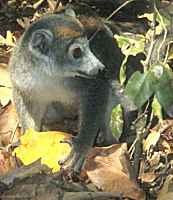 The lemurs were not getting much to eat, but they stayed there in hope and one did manage to grab a complete mango. There is a world of difference in character between a lemur and a monkey. Lemurs are much more trusting, lemurs are much more polite, it is hard to imagine a lemur biting you. In contrast monkeys are always snatching and threatening to bite. It is easy to love lemurs much more than monkeys.
The lemurs were not getting much to eat, but they stayed there in hope and one did manage to grab a complete mango. There is a world of difference in character between a lemur and a monkey. Lemurs are much more trusting, lemurs are much more polite, it is hard to imagine a lemur biting you. In contrast monkeys are always snatching and threatening to bite. It is easy to love lemurs much more than monkeys.
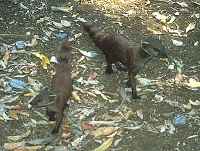 Somewhere amongst all this benefit for Fujifilm's profits, we found we were also being invaded by a family of ring-tailed mongooses and then by two families of ring-tails that were fighting a battle. These were harder to photograph than the lemurs, but fascinating to watch as they made fierce rushes at the opposing family.
Somewhere amongst all this benefit for Fujifilm's profits, we found we were also being invaded by a family of ring-tailed mongooses and then by two families of ring-tails that were fighting a battle. These were harder to photograph than the lemurs, but fascinating to watch as they made fierce rushes at the opposing family.
Somewhere in all this we had tea and the light faded. We went off with our headlamps stuck to our foreheads. Again we walked slowly along the road. By scanning with the headlamp, I had counted 18 contacts by the end of the evening but most were Lepilemurs very high in the trees and so not visible apart from the eye-reflections. There were lots of smaller creatures to be seen: insects of all types, frogs, chameleons and even exotic moths. At one point our torches caught some medium-sized birds scuttling through the undergrowth and I though "No, not again! We are knee-deep in the bloody things". Sure enough the cry rang out again "Those were White-fronted Mesites. Very rare! They are only seen in a few small areas of Madagascar." (Apologies to Nick, I could not resist it!)
A treat on the way back was when Patrick and I saw two mouse lemurs low in the trees and crossing form one to another; all quite close to the path. Finally we had an epic hunt through the undergrowth for a Cerval which had been scavenging the rubbish dump some way from the kitchen site. I believe I may have got a glimpse, but nothing recognisable.
In bed the night was noisy around the tents with the calls of lemurs. Our Lepilemurs living in a tree beside the tent were out for the night and not to be seen until next morning.
19 Nov
A really early start today, since we wanted to walk to Lac Vert and get as much ground covered as possible before it got hot. We were off down the road again carrying plenty of water and followed by a crew of porters carrying even more water.
The path eventually left the road and struck up over rocky areas through the woods. At one point it passed through a shady shallow ravine with a stream at the bottom. This is the area of the so-called "French Camp". (Where we lived is called the "English Camp")
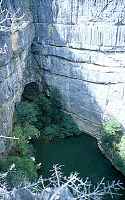 Finally we reached our destination. At that point we emerged on to a flat area which was actually formed by the tops of the blades of tsingy like a giant scrubbing brush. It could only be crossed with care (or a thoughtfully-provided wooden path!). It outlined a huge rectangular hole with a lake deep in its base. This is the Lac Vert and very spectacular it is too.
Finally we reached our destination. At that point we emerged on to a flat area which was actually formed by the tops of the blades of tsingy like a giant scrubbing brush. It could only be crossed with care (or a thoughtfully-provided wooden path!). It outlined a huge rectangular hole with a lake deep in its base. This is the Lac Vert and very spectacular it is too.
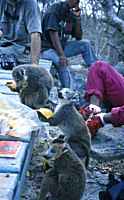 By now the day was hot and we huddled in the shade of a few small trees as we ate odd slices of the excellent-flavoured Madagascar mangos. There was a small movement in the trees and then a gang of lemurs emerged and marched down over rocks and branches to advance right to the very centre of our scattered party. On the way they passed about 20cm from my head. They clambered under and over the wooden walkway to get at our rubbish bag and its contents of mango skins. They helped themselves as we tourists took photos and the guides and porters watched in amusement.
By now the day was hot and we huddled in the shade of a few small trees as we ate odd slices of the excellent-flavoured Madagascar mangos. There was a small movement in the trees and then a gang of lemurs emerged and marched down over rocks and branches to advance right to the very centre of our scattered party. On the way they passed about 20cm from my head. They clambered under and over the wooden walkway to get at our rubbish bag and its contents of mango skins. They helped themselves as we tourists took photos and the guides and porters watched in amusement.
Again, their gentle nature shone forth. There was one lemur that realised one of our porters had a banana in his hand. It walked around the seated man and stopped before gently stretching out a paw towards the banana. The man quietly moved it to his other hand. The lemur moved round him and repeated the performance. The whole cycle was repeated yet again before the lemur decided that there was nothing doing and gently went off to search elsewhere.
Afterwards we walked back to camp. It was getting really hot now and the shade of trees was welcome where they overhang the path. After lunch we went back to our tents for the hottest part of the day.
In the afternoon Joan and I ended up in the woods at the foot of the tsingy cliffs. Surprisingly this was the first time we had examined them in detail. For me this was one of the many highlights of this trip to Madagascar and every bit as important as looking at the wildlife. I started to traverse along the foot of the cliff and met an area where thick creeper grow near-horizontally at random heights from the ground. Speed dropped to a few metres per minute: a very impressive demonstration of just how difficult passing through uncleared country could be.
By now it had sunk in that this was actually the main campsite referred to in Jane Wilson's book - the book that had made us so keen to do this trip. I met some of our camp staff who said they were off to swim. It then began to come back to me that the book had referred to a cave with a stream in it somewhere nearby. I went searching for it and found the path going steeply down, down, down through the trees apparently into the depths of the earth. I got to a point just above where I could hear our staff splashing in the water then realised that Joan would not want to miss this, so I turned and went toiling back up the path again.
It was hot and steep and by the time I got to the top I was soaked in sweat. Stopping long enough to cool off a bit, while Joan and Jean started the descent, took me to the time when I realised it was really getting too late. We needed a torch and we could be missing at the time the others were setting off for the twilight walk. So, I never saw the cave properly, which was a great pity. Its surroundings were truly dramatic and, for me, it would have been something of a pilgrimage. Joan and Jean did not fully complete the descent either.
The night walk was pleasant, but very similar to the previous night.
20 Nov
Today was a transfer day, but marred by an unfortunate incident. We packed up camp early and while Nick was packing his small tent he was bitten by something. It was possibly a scorpion, although the biter was never seen. Whatever it was, Nick had a numb and swollen arm for several days and was in great pain with it.
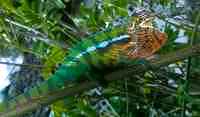 For the rest of us, the day consisted of a pleasant drive back to Diego Suarez, recognising various features along the way and stopping to photograph chameleons and ox-carts. Back at Kings Lodge we cleaned up and had a meal before going to the airport for a transfer to Sambava and the Hotel Carrefour. There was a heavy rain shower when we arrived, but it stopped soon afterwards. We went out in the garden and found the most colourful chameleon of the whole trip. Excitement enriches the colours and this one was probably trying to impress an nearby female and/or it was driving off a smaller male.
For the rest of us, the day consisted of a pleasant drive back to Diego Suarez, recognising various features along the way and stopping to photograph chameleons and ox-carts. Back at Kings Lodge we cleaned up and had a meal before going to the airport for a transfer to Sambava and the Hotel Carrefour. There was a heavy rain shower when we arrived, but it stopped soon afterwards. We went out in the garden and found the most colourful chameleon of the whole trip. Excitement enriches the colours and this one was probably trying to impress an nearby female and/or it was driving off a smaller male.
The hotel backs on to the beach and several of the group went swimming before the afternoon was finished.
21 Nov
Today saw the start of our second main undertaking: our trip to Majorejy National Park. It started with a drive of some one and a half hours to Manantenina, which is a modest village at the start of a walking trail into Majorejy.
The start was very hot in the sun. The walk took us past areas where there are many Lichee trees. Madagascar is a major source of Lichees and they were ripe for picking when we were there. The trees are large and of similar shape to an Elm. The Lichees hang from them in clusters of bright red. We were given some branches of them and one tears the red leathery skin from each fruit and sucks the soft white flesh from the stone. They taste better fresh than tinned.
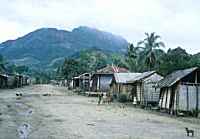 The lower part of this valley is cultivated and it eventually led us to quite a large village. The mountains of Majorejy looked very dramatic at the end of the straight main street. Soon the country became wilder and the rainforest enveloped us. The trail became a tiny footpath picking its way through the mud, over tree roots and across streams to be forded by stepping stones. It began to rain solidly and determinedly. This was to prove an asset since it keeps one cooler while walking. The final stages of the path were very muddy indeed.
The lower part of this valley is cultivated and it eventually led us to quite a large village. The mountains of Majorejy looked very dramatic at the end of the straight main street. Soon the country became wilder and the rainforest enveloped us. The trail became a tiny footpath picking its way through the mud, over tree roots and across streams to be forded by stepping stones. It began to rain solidly and determinedly. This was to prove an asset since it keeps one cooler while walking. The final stages of the path were very muddy indeed.
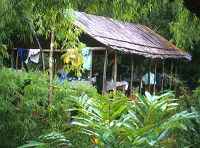 Eventually we reached Camp One. This is far from being a crude camp. The facilities are simple. The whole thing is centred around a large thatched open-sided shelter in a forest clearing. Scattered around this were a number of small thatched shelters the size of two single beds with a miniscule strip of floor between them. We gratefully changed into dry clothes and, after wringing the worst of the water out of our clothes, hung them or piled them wherever possible.
Eventually we reached Camp One. This is far from being a crude camp. The facilities are simple. The whole thing is centred around a large thatched open-sided shelter in a forest clearing. Scattered around this were a number of small thatched shelters the size of two single beds with a miniscule strip of floor between them. We gratefully changed into dry clothes and, after wringing the worst of the water out of our clothes, hung them or piled them wherever possible.
The locals had gone on ahead of us and we had a welcome meal under the thatched shelter as the rain tumbled down. During this period everyone was admiring Kathy, who had gone to sleep sitting on the floor with her back against a pole of the hut. I have never seen a more seraphic expression on the face of a sleeping adult!
This comfort was not to last. As darkness fell, Nick announced we were to have a night walk to look for nocturnals. With heavy hearts we went back to our huts and took off our lovely dry clothes and pulled on our sopping wet clothes, item by item. Then we attached our headlamps and squelched and oozed up the path in the darkness looking for eye reflections. It surprised no-one when we found a good variety of frogs here. They seemed a lot more at home than we felt (apart form one trying to remove a leech attached to the top of its head). Finally we were allowed back to our huts and our dry clothes. We went to sleep listening to the rain dripping through the trees around us.
22 Nov
 This morning we were off again plodding through mud and scrambling over tree roots on our way to Camp Two. It was raining pretty steadily, which helped against the heat. Eventually we arrived, just as the cloud lifted and the sun shone down from a blue sky. The situation was delightful since the camp was alongside an open expanse of flat rocks over which the stream swirled before plunging down a waterfall. The main feature of the camp was the dining and kitchen shelter. This was tucked into a muddy ledge nearly big enough to contain it. Above it, scattered amongst the vegetation, wherever one would fit, were our tents.
This morning we were off again plodding through mud and scrambling over tree roots on our way to Camp Two. It was raining pretty steadily, which helped against the heat. Eventually we arrived, just as the cloud lifted and the sun shone down from a blue sky. The situation was delightful since the camp was alongside an open expanse of flat rocks over which the stream swirled before plunging down a waterfall. The main feature of the camp was the dining and kitchen shelter. This was tucked into a muddy ledge nearly big enough to contain it. Above it, scattered amongst the vegetation, wherever one would fit, were our tents.
Given all this luxury we stretched out in the sunshine, steaming with the rest of our wet gear around us. I went off to sleep in the warm sunshine and by the time I woke up I had sunburnt feet and a burnt patch where my shirt had pulled up at the waist.
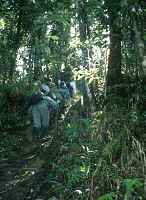 The afternoon our walk was up the steep hillside opposite the camp. It was through impressively steep rainforest. The mass of steep roots and the ascent through the trees reminded me of the ramp on Roraima. In places the "ground" felt hollow and there were quite a few spots where it was possible to peer into holes see the real ground some three metres or so below. The total of wildlife was modest and there was no sign of the Silky Sifakas. We plodded down to camp and we were just getting comfortable and the light was just going. One of the trackers came with a message that the tailenders on the descent had indeed spotted some Silky Sifakas. Too late to go back. We just contented ourselves with a quiet evening and an early night.
The afternoon our walk was up the steep hillside opposite the camp. It was through impressively steep rainforest. The mass of steep roots and the ascent through the trees reminded me of the ramp on Roraima. In places the "ground" felt hollow and there were quite a few spots where it was possible to peer into holes see the real ground some three metres or so below. The total of wildlife was modest and there was no sign of the Silky Sifakas. We plodded down to camp and we were just getting comfortable and the light was just going. One of the trackers came with a message that the tailenders on the descent had indeed spotted some Silky Sifakas. Too late to go back. We just contented ourselves with a quiet evening and an early night.
23 Nov
A very early start into a grey gloomy morning. (At 04:30 if I remember rightly) The idea was to reach the Silky Sifakas before they left their roost site of the previous night. We climbed up in the gloom but failed to get here before they left. Happily we soon located them again, but high in the trees. At first one could just get a glimpse of their long coats of hair which looked as though they had been combed. At this stage it looked as though we might be able to claim we had seen the animal that was the prime target of our trip, but we might need to look at a photo to see what they really looked like! Instead our luck improved steadily.
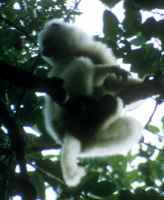 The troop of sifakas kept moving up the hill and staying more or less on the line of the path. This meant that one could go on ahead of them and wait in a region with the thinnest growth of leaves that one could find. The Sifakas might pass through this gap when they moved and if so one might get a photo. After ten or more attempts I finally got a modest photo or two and I had actually seem them in some detail, with their long white silky coats showing well enough in the grey morning light. They even began to get used to us and a little curious. Sometimes there would be a little face peering down from the branches as they went past.
The troop of sifakas kept moving up the hill and staying more or less on the line of the path. This meant that one could go on ahead of them and wait in a region with the thinnest growth of leaves that one could find. The Sifakas might pass through this gap when they moved and if so one might get a photo. After ten or more attempts I finally got a modest photo or two and I had actually seem them in some detail, with their long white silky coats showing well enough in the grey morning light. They even began to get used to us and a little curious. Sometimes there would be a little face peering down from the branches as they went past.
Eventually the sifakas sloped away into the less accessible trees and we scrambled back down to get our breakfast.
Later we set off again up the one same steep path. This time we kept climbing and the rain kept raining. In places the path was following the crest of a rocky ridge, although with the tree tops high above us it was not how one normally pictures a ridge.
Eventually we reached a small ledge with a break in the canopy beside it. This normally spectacular lookout point was covered in cloud. After a short stop we were just about to leave when a partial clearing of the clouds occurred and we did get a glimpse of the tree clad slopes opposite us.
There was some debate about what to do since the visibility in cloud was low and the rain was falling steadily. Happily we went on. The path stayed relentlessly steep, muddy and overgrown. The rain poured down and we plodded on. I rather approve of this sort of thing. When done from time to time it leaves a satisfying memory and also it is fascinating to see how well one's body will keep going on and relentlessly on in these discouraging conditions. At one point Joan asked me if she had something in her eye, but I could see nothing and we continued. From time to time our Park Guide would tell us of the fine waterfall we couldn't see on the far side of a descending valley and the cloud kept swirling.
Eventually of course we did stop and turn. We then had the whole thing down which to slither again. Most animals apart from frogs stayed somewhere safe. From time to time we saw pill millipedes, which for me are one of the great treats of Madagascar wildlife. These come in shiny black or a magnificent dark green - darker still than most other dark greens. When challenged they hide all their many feet and curl up into an almost perfect sphere with all their shiny segments on display - huge, perhaps some 8cm diameter.
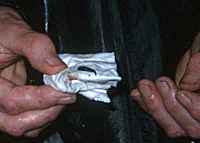 It was during this descent that Bronwen noticed something in Joan's eye. This turned out to be a leech; black and swollen with blood. We were horrified. Heri took control of the situation and folding up a tissue he swept the offending leech out of Joan's eye. A somewhat grim experience, even though it caused no long term problems!
It was during this descent that Bronwen noticed something in Joan's eye. This turned out to be a leech; black and swollen with blood. We were horrified. Heri took control of the situation and folding up a tissue he swept the offending leech out of Joan's eye. A somewhat grim experience, even though it caused no long term problems!
With the descent finally over we were treated to a good meal some time in the late afternoon. As we ate this the rain poured down relentlessly. It leaked through the roof. It splashed in under it. It ran under the tablecloth spread on the ground and oozed up through gaps in it. As we finished our meal darkness had already fallen and everyone was getting wet in their so-called dry outfits. (The stuff we had worn earlier was spread over plants around the tent to avoid bringing it inside.)
There is only one thing to do in such cases: crawl into the sleeping bag. Later there was an invitation to come down for a cup of tea and a little to eat. If the dining shelter had looked wet earlier, it certainly looked wetter now. Sleep was the only escape.
One other memory of the night is branded into my brain. Sometime during the middle of the night I realised I would have to go to the loo! It was totally and completely black and the rain came down like a vertical river. Accompanied by nothing but a Maglite I got out and felt for my boots. The water level in them was getting near the top of the ankle. I poured the water out, then put a boot on each foot and stumbled across the steeply sloping hillside covered in trackless wet interlocking plants trying to get well away from the other tents. (Sometimes it is very hard to understand why I persist on going on holidays like this!)
24 Nov
Well, that was Marojejy! We were going down to civilisation again. [As I write this I am thinking I really want to go back and feel it being so crazily hostile!]
It is all downhill going this way. It seemed to take very little time to reach Camp One. We stopped for a meal and then carried on down the path. As we lost height it became hotter and hotter. Below us we could see the remains of enormous trees blown over in last season's hurricanes. Once out of the forest we plodded past the fine Lichee trees. A relative of a porter ran out to offer a delicious branch of them.
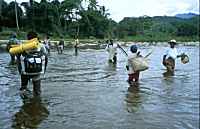 This time we took the direct route, like all the locals. Instead of walking up and over a substantial hill we waded across the river and later back again. This was fun and we smiled and laughed with the locals, who travelled alongside us.
This time we took the direct route, like all the locals. Instead of walking up and over a substantial hill we waded across the river and later back again. This was fun and we smiled and laughed with the locals, who travelled alongside us.
Eventually we reached the village by the road. It was hot and the village is grubby. The idea had been to have a quick lunch before setting off. In fact we had no lunch and no staff. The afternoon went slowly by without any change and it was quite late when all our staff appear and Tupperware boxes of lunch are issued out. Finally the explanation was drawn out and it was bizarre. Apparently all this lunch we are eating had been carried up to Camp Two by fleets of local porters. They had later come up and fetched it back down to Camp One, where our cook prepared it and the porters brought it down to the village for us to eat. What do the porters think of all this? Presumably they think we are crazy, but we pay well!
We drove back to Sambava and the Hotel Carrefour.
25 Nov
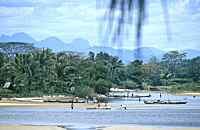 In the morning we strolled through Sambava taking photos. This was a worthwhile experience, since the inlet just along the main road had some attractive sights of water, boats and people to photograph.
In the morning we strolled through Sambava taking photos. This was a worthwhile experience, since the inlet just along the main road had some attractive sights of water, boats and people to photograph.
We also replaced (at very low price) a pair of Joan's sandals which had fallen apart. I spent some time looking at maps of Madagascar in a shop near the hotel. All our coming and going was punctuated by the pleasure of walking past the vanilla factory adjacent to the hotel, which smelt delightful.
 After lunch we travelled to the airport and flew to Tana. There our drive into the town passed through networks of shabby streets, all seething with life in little shops and workshops. Our destination was the Hotel Ibis, which had a scruffy entrance and staircase and yet it had the best-equipped and decorated modern hotel room I have ever stayed in: no resemblance to the nondescript rooms of the Ibis hotel chain in France. The view across the nearby park with Jacaranda trees in bloom was also appreciated.
After lunch we travelled to the airport and flew to Tana. There our drive into the town passed through networks of shabby streets, all seething with life in little shops and workshops. Our destination was the Hotel Ibis, which had a scruffy entrance and staircase and yet it had the best-equipped and decorated modern hotel room I have ever stayed in: no resemblance to the nondescript rooms of the Ibis hotel chain in France. The view across the nearby park with Jacaranda trees in bloom was also appreciated.
In the evening we trooped through shabby roads to arrive at a very nice restaurant where we all enjoyed an excellent meal (do any of our companions remember its name?).
26 Nov
The day started with an excellent buffet breakfast (we really can recommend the Hotel Ibis without qualification). Afterwards we returned to the airport and flew to Tulear. There we set off along the coast road to Ifaty in a fleet of 4wd vehicles. This was a new type of scenery for us; very flat and sandy with mostly scrubby vegetation studded with trees. There were standing lakes in places but between these the place was very dry, and hot too.
 Our destination was Les Paradisiers, which is an isolated hotel consisting of a central dining room above the beach surrounded by sandy gardens with small chalets at intervals. Each chalet is a hotel room and the design includes a sort of mezzanine floor up in the thatch with a small balcony above the entrance door; a very attractive layout. The view from each chalet was down a bank to the empty beach which swept for miles in each direction.
Our destination was Les Paradisiers, which is an isolated hotel consisting of a central dining room above the beach surrounded by sandy gardens with small chalets at intervals. Each chalet is a hotel room and the design includes a sort of mezzanine floor up in the thatch with a small balcony above the entrance door; a very attractive layout. The view from each chalet was down a bank to the empty beach which swept for miles in each direction.
We had some time at leisure and a pleasant evening meal. (More of that meal later!)
27 Nov
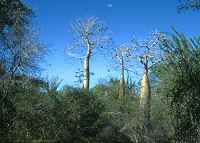 The day started very early, since it gets very hot later. We drove a short way and then went for a walk through overgrown paths between bushes and trees. The setup was unusual: the area specialises in bird-watching trips and there were other groups as well as ours. The locals know the area well and can usually find birds to demand since they know where each has its territory. Our tour area also contained some of the very distinctive Madagascar varieties of Baobab.
The day started very early, since it gets very hot later. We drove a short way and then went for a walk through overgrown paths between bushes and trees. The setup was unusual: the area specialises in bird-watching trips and there were other groups as well as ours. The locals know the area well and can usually find birds to demand since they know where each has its territory. Our tour area also contained some of the very distinctive Madagascar varieties of Baobab.
During this trip I felt very listless and tired and as the temperature increased I was finding it all rather unpleasant. Others did not seem to find these things a problem! For myself the idea of getting away from the hot woodlands and having a diving session in the sea was the thing I was looking forward to rather impatiently.
Back at Les Paradisiers we had breakfast and waited for a small boat to come and collect us. Most of us had booked for this the previous night and given details of flipper sizes etc. The tiny outboard-driven boat duly appeared and we waded out to board it. There were already several people from another hotel aboard and we all chugged along and outwards until we got to one of the coral reefs.
I had been looking forward to this (even to preparing by cutting off my moustache that morning!) and I think I was the first one into the water. The coral was impressive and the area around it swarmed with tropical fish. As I swam around enjoying these I had a few of my usual problems getting the mask to seal, but I seemed to be making heavy weather of clearing my mask and to my puzzlement I was showing all the signs of stress and tension that beginners show when they are afraid of the water. After a short time of maybe 15-20 minutes I decided to go back to the boat for a while. On arriving at it I found it hard to get out of the water and had to be more or less pulled out. Once out I gasped for air and my whole diaphragm was painful. As I stood on the boat gradually recovering, I still did not recognise the obvious: that I was ill.
I lurked about the boat and kept planning to go back into the water but delaying it. I felt weak, but not especially ill. In the end I never went back in the water. This was a terrible shame since everyone else had a superb time and they were all wildly enthusiastic about it. Finally we all went back, met up with Joan and the others who had stayed ashore and had lunch. That was it for me. I felt awful and went to bed for the rest of the day.
I think it was at lunch that we began to notice things wrong with the hotel's hygiene: such as plates of Lychees that were served with the ends opened up for decorative effect to expose the flesh of the fruit inside. They had obviously been prepared earlier since there was evidence of drying of the fruit in the heat. All this in a place where the dining room seethed with masses of flies. Les Paradisiers may have been an attractive-looking place to stay but they were certainly capable of breaking all the rules of good practice in food preparation in hot climates.
28 Nov
 The day was again started with a bird-watching trip which Joan enjoyed. I scarcely got out of bed. Some of the others in our group had some problems. Of course this meant that I missed the second session of snorkeling on another coral reef. Joan stayed ashore and enjoyed the relaxing surroundings. My only entertainment was to watch the "three-eyed" lizards quarrelling over territory.
The day was again started with a bird-watching trip which Joan enjoyed. I scarcely got out of bed. Some of the others in our group had some problems. Of course this meant that I missed the second session of snorkeling on another coral reef. Joan stayed ashore and enjoyed the relaxing surroundings. My only entertainment was to watch the "three-eyed" lizards quarrelling over territory.
In the afternoon we departed by road for Tulear where we stopped in the rambling Hotel Capricorne, built around courtyards. Joan tells me the food was good, but I just stayed in bed.
29 Nov
Today our flight to Tana was overbooked and we had to fly later in the day. To fill the time we drove out along the coast and stopped at a pretty little restaurant which overlooked the beach. We walked along the coast road from there, but it was very hot and I was still ill. However sitting in the shade in the restaurant garden was pleasant.
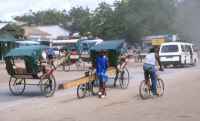 Later we went back to a hotel in Tulear where we could sit under trees while we waited. I did also take a few photos of street scenes. When we finally went back to the airport I gave my packed lunch to some of the many beggars who patrolled the airport.
Later we went back to a hotel in Tulear where we could sit under trees while we waited. I did also take a few photos of street scenes. When we finally went back to the airport I gave my packed lunch to some of the many beggars who patrolled the airport.
The flight eventually got us back to Tana where we started a hair-raising journey by coach through the darkness to Perinet. The road is winding and hilly the whole way and our driver kept up a series of dodgy overtakings which included clipping one lorry we had just overtaken. Finally we arrived and took up our accommodation in tiny cabins set in terraces (the Feon' Ny Ala Hotel). I had been feeling rather better with not eating for some long while, but I was unable to eat the dinner I had ordered.
30 Nov
We awoke to the eerie sound of Indris calling in the woods around us. After an early breakfast we went out for a walk. First we found a good-sized Boa which got passed around among us; it seemed to be almost fond of some of us. After photographs we left it hung in a tree.
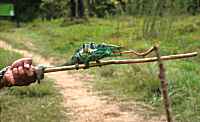 A little way past our Boa we met up with a little lad with a large Chameleon. He set this up for us on a stick and adjacent another stick with a grasshopper on it. This meant we got a first class view of the famous shooting tongue of the chameleon in action. Since the chameleon liked eating free grasshoppers, this was repeated as often as we wished and it was possible to get some photos of our chameleon in action.
A little way past our Boa we met up with a little lad with a large Chameleon. He set this up for us on a stick and adjacent another stick with a grasshopper on it. This meant we got a first class view of the famous shooting tongue of the chameleon in action. Since the chameleon liked eating free grasshoppers, this was repeated as often as we wished and it was possible to get some photos of our chameleon in action.
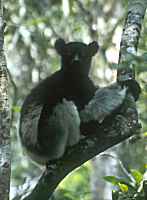 The path onwards led up and down through thick woods and took us to a family of three Indris. They were placid creatures and used to people taking photos. One big treat for us was when a series of Indri howls was passed through the forest. "Our" Indris listened with great attention to the howling and finally it came to their turn when they howled effortlessly at tremendous volume. Later we had quite a good view of some timid Bamboo lemurs.
The path onwards led up and down through thick woods and took us to a family of three Indris. They were placid creatures and used to people taking photos. One big treat for us was when a series of Indri howls was passed through the forest. "Our" Indris listened with great attention to the howling and finally it came to their turn when they howled effortlessly at tremendous volume. Later we had quite a good view of some timid Bamboo lemurs.
In the evening we went for a night walk, this time with some fireflies as an extra spectacle.
01 Dec
Today we drove to the Maromizaha Reserve for a forest nature hike along a ridge. This was a pleasant walk although I felt weak. It was not a huge success in terms of wildlife viewing but the scenery and path were very good.
Late in the afternoon we returned to our bus at the side of the road and sat around until darkness for a night walk. I hope I do not sound too ungracious, but I was delighted by the general atmosphere of the place as we waited for our walk. As darkness fell the fireflies gradually got going on their nightly meanderings. In contrast the walk in crocodile along the narrow path with lights swivelling in all directions seemed like a desecration. Maybe I would have felt less extreme in my reactions if I had been feeling better.
When we got back to our hotel I ordered dinner but started to feel too ill to eat.
02 Dec
Today I was not fit for a walk: scouring vomiting and weakness. I got up to see-off Joan and the others on their bus. I then spent the whole day flat out in bed until Joan returned, having had a good day. She covered much interesting ground and saw much wildlife.
Afterwards we piled into our bus and drove back to Tana where we had use of some rooms at the Hotel Cheval-blanc for a shower. Finally we went to the airport and caught our flight back home.
03 Dec
Back via Charles de Gaulle to Heathrow.
Comment
More photographs
1 Animals
|
2 Scenery
More pages and information about Madagascar
Index of all diaries
|
Our Home Page
|
Tour Agent
 After a slightly rushed breakfast (I set our clock an hour out!) we set off by road in a fleet of comfortable 4wd vehicles. We were on our way to the Ankarana Special Reserve. The initial part of the journey was along superb tarmac roads carrying little traffic. After these we turned off to dirt roads and began to see why the 4wd vehicles were needed for most of the year. For us in November, there was only dust and a bumpy surface to contend with, but there was much evidence of fierce struggles back in the rainy season. e.g. There were tree branches embedded in the mud and multiple wheel grooves over a huge area each side of the official road. We saw few vehicles on the road and these included a good sprinkling of ox-carts.
After a slightly rushed breakfast (I set our clock an hour out!) we set off by road in a fleet of comfortable 4wd vehicles. We were on our way to the Ankarana Special Reserve. The initial part of the journey was along superb tarmac roads carrying little traffic. After these we turned off to dirt roads and began to see why the 4wd vehicles were needed for most of the year. For us in November, there was only dust and a bumpy surface to contend with, but there was much evidence of fierce struggles back in the rainy season. e.g. There were tree branches embedded in the mud and multiple wheel grooves over a huge area each side of the official road. We saw few vehicles on the road and these included a good sprinkling of ox-carts.





















